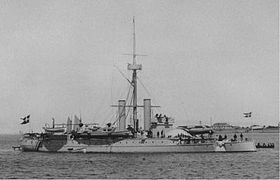Tordenskjold (ship, 1880)
|
|
|
|---|---|
 The Danish ironclad Tordenskjold 1884 |
|
| Overview | |
| Type | Coastal armored ship |
| Shipyard | |
| Keel laying | June 5, 1879 |
| Launch | September 30, 1880 |
| Namesake | Peter Wessel Tordenskiold |
| Commissioning | September 29, 1882 |
| Whereabouts | Sold for demolition May 14, 1908 |
| Technical specifications | |
| displacement |
2534 t |
| length |
67.8 m over everything |
| width |
13.2 m |
| Draft |
4.8 m |
| crew |
229 men |
| drive |
4 cylinder boilers , |
| speed |
13.3 kn |
| Range |
1500 nm at 9 kn |
| Armament |
1 × 35.5 cm L / 25 cannon |
| Fuel supply |
170 tons of coal |
| Armored deck |
up to 95 mm |
The Danish coastal armored ship Tordenskjold was created as a large armored gunboat due to lack of sufficient budget. Because of its strong torpedo armament and the possibility of carrying two small torpedo boats, it was initially called "torpedoskib" and was not reclassified to "panserskib" until 1885. The Tordenskjold was the first ship in the Danish Navy to be built predominantly from steel and which had electric lighting. Her 35.5 cm bow cannon was the largest caliber weapon ever installed on a Scandinavian warship.
The coastal armored ship was named after the Norwegian-Danish naval hero Peter Wessel Tordenskjold (1690–1720, most recently Vice Admiral), whose name had previously been borne by a 1453 t frigate that was in service from 1854 to 1872.
Building history
In 1877, the Danish Navy planned an improved version of the 5480 t ironclad Helgoland, which was still under construction . The funds in the budget for the years 1878–1879 were only sufficient for an armored gunboat and so the Tordenskjold was not even half the size of the Helgoland . Their armor was limited to an armored deck and the protection of the main weapon. With a caliber of 35.5 cm, this was the largest breech-loader that a warship in Scandinavia had ever had. The cannon supplied by Krupp was 8.9 m long and was nicknamed "Tall Tom". However, the heavy cannon could only fire once in 10 minutes and then shook the entire ship. The cannon was moved and aimed with a hydraulic system and the ammunition was transported from the magazine to the weapon, so that the number of operations could be reduced to 16 men. The Helgoland needed 19 men to operate its 30.5 cm cannon. The range of the 35.5 cm Krupp cannon was 9000 m.
The four 12 cm guns on the quarterdeck could fire every two minutes. They were originally unprotected, but were given steel protective shields in 1889. The Tordenskjold was able to carry two small torpedo boats 2nd class of 15 t, which were designated as numbers 4 and 5 . These boats supplied by Thornycroft and the four own torpedo tubes of Tordenskjold led to the initial name as "torpedo ship". On December 18, 1885, the Tordenskjold was assigned to the armored ships. The small torpedo boats were then no longer carried. The small Thornycroft boats of 18.8 m in length, ran 15.6 knots and were armed with two torpedo tubes and a revolver cannon. They remained in service until 1898 (loss N ° 5 due to collision) and 1911.
The Tordenskjold was the first steel-built ship in the Danish Navy and also the first with internal electrical lighting.
Mission history
During the service of the Tordenskjold , the Danish naval units were usually only in service in the summer, which was also true for the naval units of other nations at least to a large extent.
In 1882, 1883 and 1884 the ship took part in the summer squadron exercises with its torpedo boats. From 1885 they were not carried and they were used as small transport boats. The Tordenskjold also belonged to the maneuver fleet in 1887, 1891, 1894 and took part in visits to Germany and Russia. During the mission in 1897, the ship, together with the Helgoland and the four torpedo boats of the Støren class , made a visit to Stockholm in September on the occasion of the 25th anniversary of the reign of the Swedish King Oscar II . After an overhaul, the Tordenskjold was used again in 1899 and then for the last time from July 20 to September 28, 1901.
On May 14, 1908, the ship in reserve was sold to Stettin to be scrapped .
The following Danish coastal armored ships
| Surname | Launch | displacement | speed | Main armament |
|---|---|---|---|---|
| Iver Hvitfeldt | April 14, 1886 | 3,478 t | 15.1 kn | 2 × 26 cm L / 35 |
| Skjold | May 8, 1896 | 2,195 t | 13.4 kn | 1 × 24 cm L / 40 |
| Herluf trolls | September 2, 1899 | 3,505 t | 15.6 kn | 2 × 24 cm L / 40 |
| Olfert Fischer | May 9, 1903 | 3,650 t | 15.8 kn | 2 × 24 cm L / 43 |
| Peder Skram | May 2, 1908 | 3,735 t | 16.0 kn | 2 × 24 cm L / 43 |
Renewed use of the name
From 1978 the Danish Navy received three corvettes of the Niels-Juel class (1320 ts), including the Peter Tordenskiold (F 354) as the third ship in 1982 . The three corvettes were decommissioned in 2009.
literature
- R. Steen Steensen: Vore panserskibe. Marinehistorisk Selskab, 1968.
Web links
Individual evidence
- ↑ Torpedo boat 2nd class No.5 was lost in 1898 due to a collision with the German steamer Doktor Siegler (1 dead).


